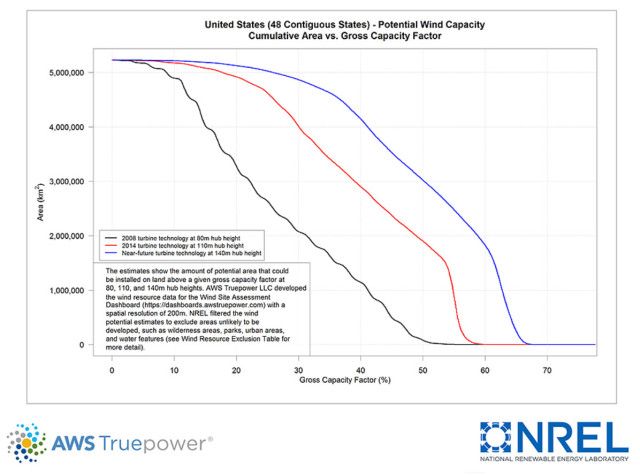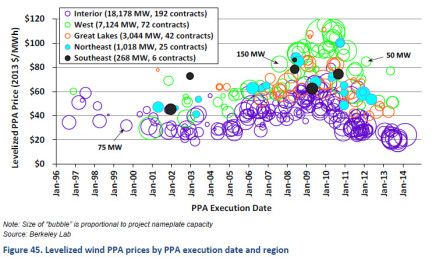The National Renewable Energy Laboratory (NREL) recently released data showing that the capacity factor (CF) for wind power can reach 65 percent -- comparable to the CF of fossil-fuel-based generation.
While the headlines aren’t as sexy as Tesla’s "Ludicrous mode," the transformative implications for climate change dwarf Elon Musk’s latest accomplishment. Increasing a generator’s CF can increase its value in a variety of ways, including: reduced cost of energy, improved transmission-line utilization, and often, reducing stress on the grid by providing more power at times of peak demand. It will also likely reduce the amount of storage and natural gas needed to manage the grid under scenarios of high renewables penetration. Implicitly, NREL’s new report positions wind to become a dominant and possibly the primary source of electricity in the U.S.
Figure 1: Areas of the U.S. With Various Gross Capacity Factors for Differing Wind Technologies
Source: NREL
Note: The curve to the left shows the historical data, the middle (red) curve shows the data for state-of-the-art turbines, and the blue shows the anticipated performance of "near-future" turbines.
CF is the ratio of a generator’s average power output over a year to its nameplate rating. A CF of 100 percent would indicate that the generation source was always on and operating at its full rated power. Simply stated, a higher capacity factor means a generator of a given size will produce more energy over the year. CF sets a lower bound on the amount of time that a generator operates. If a generator is not operating at its full nameplate rating all the time, then it will produce power for a percentage of time that exceeds its CF.
With little fanfare, NREL released updated data showing that, with current technology, wind turbines could generate more than enough energy at 55 percent CF to power the entire U.S. However, the real stunner is that near-future turbine technology (i.e., 140-meter towers) could boost that to 65 percent CF. With the current national average wind CF (see page 34) at about 33 percent, this represents a near doubling. According to NREL, using current technology and siting it in prime locations, wind power CF can already exceed that of natural gas. Using "near-future" technology, wind power’s CF will exceed the CFs of both coal (61 percent) and natural gas (48 percent) achieved nationwide in recent years.
(It is important to keep in mind that fossil-fuel plants are dispatchable and often their output is often reduced in response to reduced demand. So, theoretical maximum CF is often more than what is realized in practice. This also occurs for wind through curtailment, but at current penetrations, to a lesser degree. These distinctions are quantified by utilities using a metric called capacity credits, which is discussed below.)
Taking CF into account, on an energy basis, there is enough suitable land available to site 65-percent-CF turbines to supply the nation's electrical energy needs. Take from NREL’s new data, Figure 1 shows how our understanding of wind’s potential is rapidly evolving. Advances in turbine technology are leading to taller turbines that can access the steadier, higher average speed winds at higher altitudes. Using Figure 1 and data from this study, one finds that there is enough land available to site turbines with 1.5 terawatts of capacity and 65 percent CF. At 55 percent CF, there is enough land with sufficient resource to site roughly 3 times that, for a total of about 4.5 terawatts. For perspective, the average U.S. electrical net generation was less than 0.5 terawatts in 2012. Even with higher CF, wind power is not dispatchable and therefore will not eliminate the need for other sources. However, it can dramatically reduce the percentage of generation from fossil fuels.
Coal and natural gas are currently the country’s primary generation sources. According to the EIA, in 2014, coal power plants produced 39 percent of the nation’s electrical energy, with gas in second place at 27 percent. Some reputable authors argue that current economics (which do not consider load-shifting) place a limit on the upper bound of renewables penetration equal to their capacity factor. That criteria sets an upper bound for wind power’s contribution to the nation’s electric supply at 65 percent of the total. However, in the near term, the limiting factor may be technical. A DOE-funded study carried out by GE suggests that the grid can tolerate about 55 percent wind and solar, with the total being raised to 61 percent if the grid were reinforced with commercially available improvements. Using either metric and technology available today, the only remaining barrier to wind becoming the nation’s largest energy source is transmission capacity.
Transmission line utilization
The best wind resource in the U.S. is in the Great Plains region, but the largest loads are on the coasts. For the most part, the economics of low-CF wind power have required that it be built relatively close to existing transmission lines rather than building new lines. As such, only a small fraction of the country’s best wind sites have been developed to date. To get the power from source to load will require expanding the transmission grid. This will include adding dedicated transmission lines. In the past, it has been argued that these lines would be underutilized and therefore comparatively costly on a dollars-per-megawatt-hour basis. High CF wind improves the overall economics of dedicated transmission lines by using a higher percentage of their available capacity.
The cost improvement for transmission of high CF wind power is roughly proportional to the improvement in the CF -- so doubling the capacity factor approximately doubles the transmission line utilization. This, in turn, halves the cost per unit of energy transferred. The Great Plains region tends to have the lowest population density in the country. Not surprisingly, there is little transmission access, since very little electricity is required by the residents.
Developing the high-CF sites will require new transmission lines capable of shipping high volumes of electrical power over long distances and/or connecting to larger existing transmission assets. In the past, some stakeholders have expressed concern about building new transmission lines due to under-utilization. However, the higher-CF wind now elevates wind to levels of transmission-line utilization comparable to that of traditional sources. For perspective, with wind power being produced at 65 percent CF, it will utilize the transmission assets at about 65 percent, while traditionally the transmission infrastructure is utilized at about 60 percent.
As icing on the cake, there is already some transmission line upgrade activity underway. This is particularly true in Texas, which has upgraded transmission capacity specifically to expand its use of wind power. The new data suggests that as the near-future turbines are commercialized, these transmission projects will have better economics than originally planned.
Economics of capacity factor
Recall that CF is the ratio of a turbine’s mean power production divided by its nameplate rating. All other things equal, if a generator runs at a high capacity factor, the economics improve. For example, a 3-megawatt wind turbine running at 33 percent capacity factor and charging $30 per megawatt-hour for electricity will generate about $260,000 in annual revenue. That same turbine running at 65 percent capacity factor would produce $512,000. Alternatively, it could charge $15.5 per megawatt-hour and end up with the same profits as the 33 percent CF unit, making it more competitive. When transmission capacity is available, the economics of wind are already quite good in the Great Plains region. Moving to near-future turbines will likely further improve those economics.
Figure 2: Levelized Wind PPA Prices by Execution Date and Region
Source: Lawrence Berkeley National Lab
Note: The interior region is shown as purple circles.
Figure 2 shows that recent power-purchase agreements have been coming in at under $30 per megawatt-hour in that region. The industry trend has been toward larger turbines and lower costs. While it is the case that land-based turbine size has stalled at about 3 megawatts, that is largely due to the transportation challenges associated with getting the turbines to site. One key characteristic of the "near-future" turbines is that they are designed to address these transportation issues. NREL apparently sees sufficient promise and progress to refer to the required technology as "near- future." No doubt Europe’s success at commercializing turbines with 140-meter hub heights adds to NREL's confidence.
Increased capacity credit
The capacity credit (CC) is the metric used by utilities to account for a generator’s intermittency and its ability (or inability) to provide power at times of peak demand. The topic of CC (often found by determining the electric load carrying capability, or ELCC ) is very important in utility planning and valuing of generation assets; it is discussed in detail here. It has to do with the fraction of a generator’s rated capacity that can be relied upon as being available by the utility when it is most needed. The best approaches for calculating it look not only at the availability of the generator throughout the year, but also how well that availability correlates with peak demand on the grid. It is a complex business and is best done with high-quality, real-world data. However, in the absence of real data, analytical techniques are used by utilities to begin planning, and then the CC is corrected with data as generation is brought on-line.
It is worth considering that the increase in CC from today’s value could be more than 100 percent if the increased generation occurs at times that the grid is most in need of power. This in turn will increase wind power’s value and the degree of penetration that can be readily accommodated by the grid. In the southern Great Plains region, including Texas, Oklahoma and Kansas, the wind tends to blow more at night, a period which is off-peak. However, one benefit of taller turbines is that they reach regions of steadier wind. This will tend to increase wind speeds during the day, which in turn will contribute more to the CC than would increases at night. When all is said and done, real data will be required to determine the degree to which the CC will increase. However, it is very likely that CC will increase substantially and that it will increase the amount of wind that can usefully and economically be added to the system.
Conclusion
The new CF numbers from NREL dramatically shift the landscape for how to proceed with energy policy in the U.S. Older studies such as the Eastern Wind Integration and Transmission Study are now obsolete. They used numbers similar to the black line shown in Figure 1 and ignored the storage and load-shifting potential of electric vehicles. In those studies, wind penetration up to about 30 percent was examined and presented as reasonable to pursue. Using the blue line in Figure 1 with 65 percent capacity factor indicates that higher, probably much higher, penetrations can be achieved and at lower cost than previously anticipated. The capacity credit that can be assigned to this resource will go a long way toward determining whether the ramifications of the new data are evolutionary or revolutionary. However, the new NREL data significantly strengthens the case for increasing the rate of expansion of wind power in the U.S. energy portfolio.
***
Clayton Handleman is a 20-year veteran of the renewable energy industry whose work has spanned engineering, product development, marketing, and executive management in inverters, data acquisition systems, and related educational products and services.





